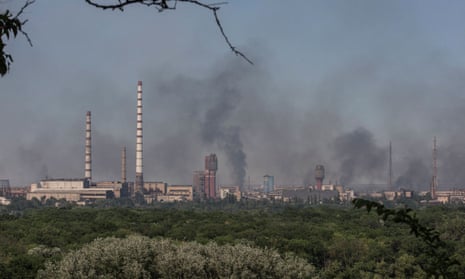Fierce fighting has continued in the strategic city of Sievierodonetsk in eastern Ukraine, where Russian shelling caused a fire at a chemical plant in which hundreds of civilians are believed to have taken shelter during some of the most intense bombardment of the war.
The governor of Luhansk region, Serhiy Haidai, said in an interview with local television that the Azot chemical plant remained under Ukrainian control, adding that fighting was under way on Sunday on the “outskirts of the city, in the streets directly near the plant”.
Russian troops had also blown up a bridge over the Siverskyi Donets River that was a possible evacuation route from Sievierodonetsk to Lysychansk, where artillery fire on Sunday killed one woman and destroyed four houses, Haidai said.
Sievierodonetsk has become the focal point of Moscow’s efforts to advance in eastern Ukraine with Russian offensives shifting their focus on to capturing the Luhansk and Donetsk regions, collectively known as the Donbas, after their failure to quickly seize Ukraine’s capital, Kyiv.
Capturing Sievierodonetsk and its twin city of Lysychansk would give Russia full control over Luhansk.
During his nightly address on Saturday, President Volodymyr Zelenskiy said that “fierce street fights continue in Sievierodonetsk”, adding that the Donbas region was “holding up”.
“Remember how in Russia, at the beginning of May, they hoped to seize all of the Donbas?” the president said. “It’s already the 108th day of the war, already June. Donbas is holding on.”
Haidai on Sunday reiterated that Ukraine remains in control of the Azot plant, the largest chemical plant in Sievierodonetsk, where hundreds of civilians are sheltering.
The Ukrainian official also dismissed as “lies” claims made by Russian-backed separatists that 300 to 400 Ukrainian fighters were trapped in the plant which was under a “blockade”.
“Russia is throwing all its forces in order to capture this city and control it in full, but has not succeeded so far,” Haidai added.
Ukrainian officials previously rejected potential comparisons between the situation in Azot and the months-long siege of the Azov steel mill in the port city of Mariupol, where civilians and Ukrainian fighters were holed up for weeks under Russian attack.
The fighting is among the toughest Ukraine has faced since Russia’s invasion on 24 February. The UK’s Ministry of Defence said in its latest intelligence update that Moscow was using its superiority in force ratio and artillery to gradually seize territory in and around Sievierodonetsk, adding that Russia has probably started preparing to deploy the third battalion from some combat formations to increase its offensive capacity.
“Deploying all three of their battalions simultaneously will likely reduce formations’ longer-term capacity to regenerate combat power after operations,” the intelligence update added.
Ukrainian officials have repeatedly warned over the last week that their military was quickly running out of ammunition and losing against Russia on the frontlines, calling on its western partners to step up their supply of heavy weapons. Ukrainian officials have also admitted that its casualties are running at a rate of somewhere between 600 and 1,000 a day.
Pointing to Russia’s military superiority in Sievierodonetsk, Haidai said: “The enemy’s artillery is simply dismantling – floor-by-floor – the houses used by our troops as shelters.
“So, when we push the enemy out of one street, they start using their tanks and artillery to destroy the area house-by-house,.”
An unnamed senior US defence official told the Washington Post at the weekend that Russia is likely to seize control of the entire Luhansk region within a few weeks as Ukraine’s supplies of ammunition decline.
Russia’s defence ministry said on Sunday its cruise missiles had destroyed a large depot containing US and European weapons in Ternopil in western Ukraine, a claim disputed by Ukrainian officials who said no weapons were stored there.
The Ternopil region governor said that a rocket attack on the city of Chortkiv launched by Russia from the Black Sea had partially destroyed a military facility as well as a number of residential buildings, injuring 22 people, including seven women and a 12-year-old.
The Guardian could not independently confirm either of the differing accounts.
The strike was a rare attack in the west of the country, and air raid sirens were also heard in the city of Lviv, close to the Polish border.
Elsewhere in the country, Zelenskiy said the Ukrainian army was gradually liberating territory further west in the Kherson region and had had some successes in Zaporizhzhia, the only large city in south-eastern Ukraine under Ukrainian control.
In Moscow, his counterpart, Vladimir Putin, on Sunday called on Russians to be “united” as he congratulated his country on the occasion of its national day.
“Today we are especially aware of how important it is for the Fatherland, for our society, for the people to be united. Such unity, devotion to the Motherland, is a responsibility passed on to us by our ancestors,” the Russian president said during a televised ceremony in which he pinned awards on pro-Kremlin scientific and cultural figures.
Putin last week compared himself to the 18th-century Russian tsar Peter the Great, drawing a parallel between what he portrayed as their twin historic quests to win back Russian lands.
